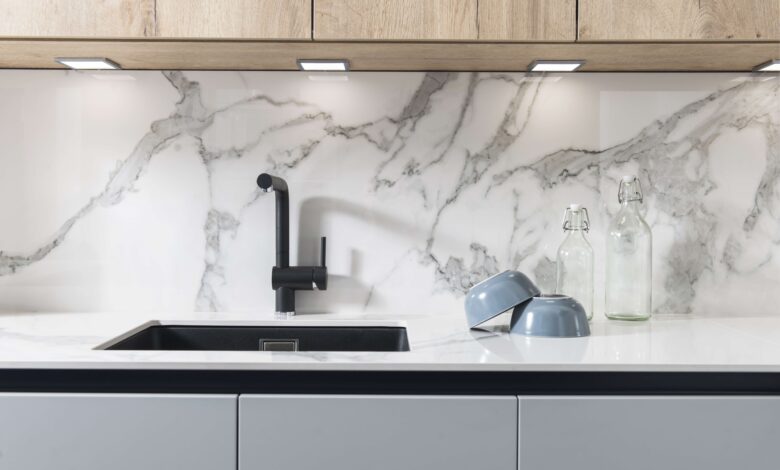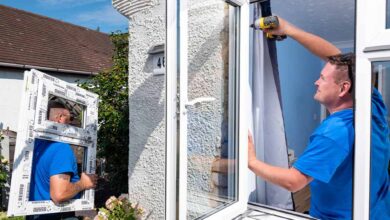The Technical Breakdown of Porcelain Worktops

Introduction
Beneath the sleek, beautifully printed surfaces of porcelain worktops lies an impressive story of material innovation and advanced engineering. To truly understand why this surface performs so exceptionally, it’s worth exploring beyond the aesthetics and examining the science behind its strength.
Porcelain isn’t just a visually striking option it’s a highly refined composite material that undergoes an intense transformation under heat and pressure to become one of the toughest and most resilient worktop surfaces available today. This technical overview breaks down the raw materials, the manufacturing and vitrification processes, and the testing standards that confirm porcelain’s legendary resistance to heat, stains, scratches, and UV exposure.
The Raw Ingredients: The Foundation of Strength
At the heart of every porcelain worktop is a carefully balanced blend of natural minerals. Unlike engineered quartz surfaces, which rely on resins to bind stone particles together, porcelain is almost entirely mineral-based. Its formula primarily includes purified kaolin clay, feldspar, silica, and other trace minerals each chosen for its specific contribution to the material’s properties.
Kaolin adds flexibility during forming, feldspar acts as a flux that promotes vitrification, and silica (in quartz form) imparts structural rigidity and hardness. These ingredients are ground into an ultra-fine powder, ensuring consistent particle size and distribution. This fine granularity allows for extremely dense compaction during pressing, minimizing internal voids and micro-gaps.
Before it ever enters a kiln, this precise formulation ensures that porcelain already possesses the foundation for its hallmark qualities density, hardness, and exceptionally low porosity.
Manufacturing: Where Art Meets Engineering
The production of porcelain worktops involves two critical stages — compaction and firing — both of which transform the powdered mixture into a solid, high-performance slab.
First, the refined powder is evenly spread onto a conveyor system and subjected to immense pressure in a hydraulic press. These industrial presses exert thousands of tons of force, compressing the powder into a highly compact “green” slab and eliminating nearly all trapped air.
Next comes the aesthetic stage digital printing. Using state-of-the-art inkjet technology, intricate surface patterns are applied to the slab with microscopic precision. The ceramic pigments used are specially formulated to endure the extreme temperatures of the firing process. This technology allows manufacturers to replicate natural materials such as marble, limestone, or even concrete, with stunning, photographic realism.
Following printing, the slab is fired in a kiln the most crucial and transformative step in the entire process.
The Science of Vitrification: Creating a Non-Porous Shield
During kiln firing, the porcelain slab undergoes a process known as vitrification, where it is exposed to temperatures exceeding 1200°C (about 2200°F). Under this heat, the feldspar and other fluxes melt, forming a glass-like matrix that fuses the quartz and clay particles together.
This transformation eliminates any remaining microscopic pores, resulting in a dense, non-porous structure. Once vitrified, the porcelain becomes a glass-reinforced ceramic — completely resistant to moisture and staining.
This is the science behind the material’s remarkable surface properties. Because there are no open pores for liquids or pigments to seep into, porcelain resists stains even from agents like wine, oil, or acid. On the Mohs scale of hardness, porcelain typically ranks between 7 and 8 — meaning it can easily withstand scratching from everyday utensils or cookware (a steel knife rates around 5.5).
The combination of extreme pressure and intense heat not only locks in strength but also permanently embeds the colour and pattern, ensuring the surface never fades or wears away.
Proven Performance: The Science of Strength
The durability of porcelain worktops isn’t marketing hype it’s proven through standardized testing and strict international quality controls. Several key performance metrics demonstrate just how advanced this material truly is:
- PEI Rating (Abrasion Resistance): Most porcelain slabs achieve a rating of 4 or 5, meaning they can withstand heavy foot traffic in commercial settings — far exceeding the demands of a domestic kitchen.
- Stain Resistance: Tested using substances such as coffee, oil, and dyes, porcelain consistently receives the top rating, proving that even long-term exposure leaves no trace.
- Thermal Shock Resistance: Porcelain endures rapid shifts between extreme heat and cold without cracking — a testament to its stable, inorganic structure.
- UV Resistance: Unlike quartz, which contains resins that can yellow or fade over time, porcelain’s mineral-based composition is completely unaffected by ultraviolet light, making it ideal for outdoor kitchens and sunlit spaces.
These test results confirm what homeowners and designers already know porcelain worktops offer unmatched resilience, outperforming most natural and engineered alternatives.
Conclusion: Beauty Engineered to Last
Behind every elegant porcelain surface is a story of precision science and technological mastery. The combination of carefully selected minerals, immense pressure, high-temperature firing, and cutting-edge digital artistry creates a product that balances beauty with extraordinary strength.
It’s this perfect marriage of art and engineering that allows porcelain worktops to deliver the aesthetics of natural stone while offering durability that few other materials can match. Whether for residential kitchens or demanding commercial environments, porcelain stands as a testament to what’s possible when craftsmanship meets material science — a surface designed not just to look beautiful, but to stay beautiful for decades to come.




